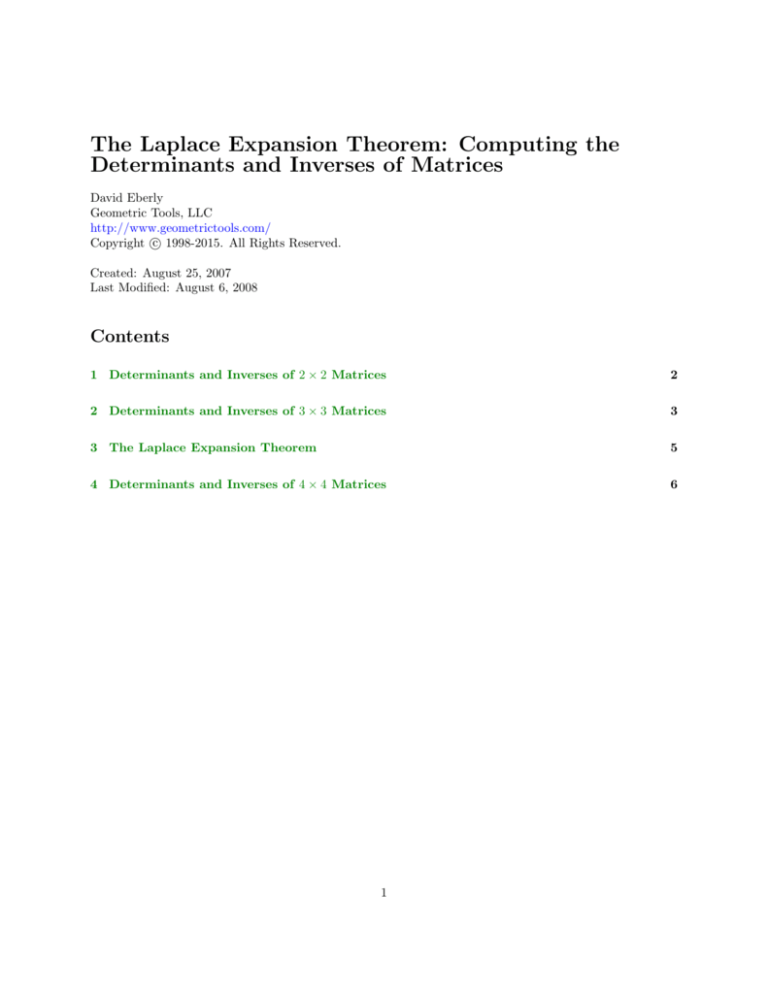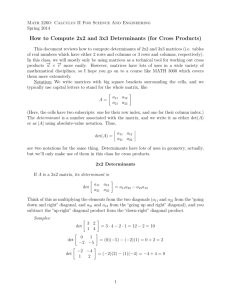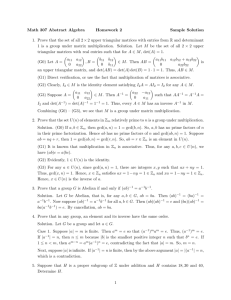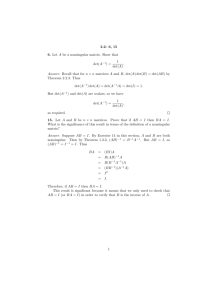
The Laplace Expansion Theorem: Computing the
Determinants and Inverses of Matrices
David Eberly
Geometric Tools, LLC
http://www.geometrictools.com/
c 1998-2015. All Rights Reserved.
Copyright Created: August 25, 2007
Last Modified: August 6, 2008
Contents
1 Determinants and Inverses of 2 × 2 Matrices
2
2 Determinants and Inverses of 3 × 3 Matrices
3
3 The Laplace Expansion Theorem
5
4 Determinants and Inverses of 4 × 4 Matrices
6
1
A standard method for symbolically computing the determinant of an n × n matrix involves cofactors and
expanding by a row or by a column. This document describes the standard formulas for computing the
determinants of 2 × 2 and 3 × 3 matrices, mentions the general form of Laplace Expansion Theorem for which
the standard determinant formulas are special cases, and shows how to compute the determinant of a 4 × 4
matrix using (1) expansion by a row or column and (2) expansion by 2 × 2 submatrices. Method (2) involves
fewer arithmetic operations than does method (1).
1
Determinants and Inverses of 2 × 2 Matrices
The prototypical example is for a 2 × 2 matrix, A = [arc ], where the row index satisfies 0 ≤ r ≤ 1 and the
column index satisfies 0 ≤ c ≤ 1. The matrix is
a00 a01
A=
a10 a11
Expanding by the first row,
det(A) = +a00 · det[a11 ] − a01 · det[a10 ] = a00 a11 − a01 a10
(1)
where the determinant of a 1 × 1 matrix is just the single entry of that matrix. The terms in the determinant
formula for a 2 × 2 matrix involve the matrix entries in the first row, an alternating sign for these entries,
and determinants of 1 × 1 submatrices. For example, the first term in the formula uses row entry a00 , sign
+1, and submatrix [a11 ]. The row entry a00 has row index 0 and column index 0. The submatrix [a11 ] is
obtained from A by deleting row 0 and column 0. The second term in the formula uses row entry a01 , sign
−1, and submatrix [a10 ]. The row entry a01 has row index 0 and column index 1. The submatrix [a10 ] is
obtained from A by deleting row 0 and column 1.
Similarly, you may expand by the second row:
det(A) = −a10 · det[a01 ] + a11 det[a00 ] = −a10 a01 + a11 a00
(2)
The first term in the formula uses row entry a10 , sign −1, and submatrix [a01 ]. The row entry a10 has row
index 1 and column index 0. The submatrix [a01 ] is obtained from A by deleting row 1 and column 0. The
second term in the formula uses row entry a11 , sign +1, and submatrix [a00 ]. The row entry a11 has row
index 1 and column index 1. The submatrix [a00 ] is obtained from A by deleting row 1 and column 1.
Expansions by column are also possible. Expanding by the first column leads to
det(A) = +a00 · det[a11 ] − a10 · det[a01 ] = a00 a11 − a10 a01
(3)
and expanding by the second column leads to
det(A) = −a01 · det[a10 ] + a11 · det[a00 ] = −a01 a10 + a11 a00
(4)
The four determinant formulas, Equations (1) through (4), are examples of the Laplace Expansion Theorem.
The sign associated with an entry arc is (−1)r+c . For example, in expansion by the first row, the sign
associated with a00 is (−1)0+0 = 1 and the sign associated with a01 is (−1)0+1 = −1. A determinant of
a submatrix [arc ] is called a minor. The combination of the sign and minor in a term of the determinant
2
formula is called a cofactor for the matrix entry that occurred in the term. For example, in the second term
of Equation (1), the sign is −1, the minor is det[a10 ], and the cofactor is −a10 . This cofactor is associated
with the matrix entry a01 . The cofactors may be stored in a matrix called the adjugate of A,
+a11 −a10
adj(A) =
(5)
−a01 +a00
This matrix has the property
A · adj(A) = adj(A) · A = det(A) · I
(6)
where I is the 2 × 2 identity matrix. When det(A) is not zero, the matrix A has an inverse given by
A−1 =
2
1
· adj(A)
det(A)
(7)
Determinants and Inverses of 3 × 3 Matrices
Consider a 3 × 3 matrix A = [arc ], where the row index satisfies 0 ≤ r ≤ 2 and the column index satisfies
0 ≤ c ≤ 2. The matrix is
a00 a01 a02
A = a10 a11 a12
a20 a21 a22
Expanding by the first row,
det(A)
=
+a00 · det
a11
a12
a21
a22
− a01 · det
a10
a12
a20
a22
+ a02 · det
a10
a11
a20
a21
=
+a00 (a11 a22 − a12 a21 ) − a01 (a10 a22 − a12 a20 ) + a02 (a10 a21 − a11 a20 )
=
+a00 a11 a22 + a01 a12 a20 + a02 a10 a21 − a00 a12 a21 − a01 a10 a22 − a02 a11 a20
(8)
Each term in the first line of Equation (8) involves a sign, an entry from row 0 of A, and a determinant of
a submatrix of A. If a0c is an entry in row 0, then the sign is (−1)0+c and the submatrix is obtained by
removing row 0 and column c from A.
Five other expansions produce the same determinant formula: by row 1, by row 2, by column 0, by column
1, or by column 2. In all six formulas, each term involves a matrix entry arc , an associated sign (−1)r+c ,
and a submatrix Mrc that is obtained from A by removing row r and column c. The cofactor associated
with the term is
γrc = (−1)r+c det Mrc
The matrix of cofactors is Γ = [γrc ] for rows 0 ≤ r ≤ 2 and for columns 0 ≤ c ≤ 2. The transpose of the
matrix of cofactors is called the adjugate matrix, denoted adj(A), and as in the 2 × 2 case, satisfies Equation
(6). When the determinant is not zero, the inverse of A is defined by Equation (7). In the case of the 3 × 3
3
matrix, the adjugate is
+(a11 a22 − a12 a21 ) −(a01 a22 − a02 a21 )
+(a01 a12 − a02 a11 )
adj(A) = −(a10 a22 − a12 a20 ) +(a00 a22 − a02 a20 ) −(a00 a12 − a02 a10 )
+(a10 a21 − a11 a20 ) −(a00 a21 − a01 a20 ) +(a00 a11 − a01 a10 )
The first line of Equation (8) may be written also as
a11 a12
a
− det[a01 ] · det 10
det(A) = + det[a00 ] · det
a21 a22
a20
a12
a22
+ det[a02 ] · det
(9)
a10
a11
a20
a21
(10)
which is a sum of products of determinant of submatrices, with alternating signs for the terms. A visual way
to look at this is shown in Figure (1).
Figure 1 A visualization of the determinant of a 3 × 3 matrix.
Each 3 × 3 grid represents the matrix entries. The blue-colored cells represent the 1 × 1 submatrices in the
determinant formula and the red-colored cells represent the 2 × 2 submatrices in the determinant formula.
In the left 3 × 3 grid of the figure, the blue-colored cell represents the submatrix [a00 ] from the first term in
the determinant formula. The red-colored cells are the complementary submatrix of [a00 ], namely, the 2 × 2
submatrix that is part of the first term of the formula: the first row has a11 and a12 and the second row has
a21 and a22 . The submatrix is obtained from A by removing row 0 and column 0.
In the middle 3 × 3 grid of the figure, the blue-colored cell represents the submatrix [a01 ] from the second
term in the determinant formula. The red-colored cells are the complementary submatrix of [a01 ], namely,
the 2 × 2 submatrix that is part of the second term of the formula: the first row has a10 and a12 and the
second row has a20 and a22 . The submatrix is obtained from A by removing row 0 and column 1.
In the right 3 × 3 grid of the figure, the blue-colored cell represents the submatrix [a02 ] from the third term
in the determinant formula. The red-colored cells are the complementary submatrix of [a02 ], namely, the
2 × 2 matrix that is part of the third term of the formula: the first row has a10 and a11 and the second row
has a20 and a21 . The submatrix is obtained from A by removing row 0 and column 2.
4
3
The Laplace Expansion Theorem
This theorem is a very general formula for computing the determinant of an n × n matrix A. First, some
definitions. Let r = (r1 , r2 , . . . , rk ) be a list of k row indices for A, where 1 ≤ k < n and 0 ≤ r1 <
r2 < · · · < rk < n. Let c = (c1 , c2 , . . . , ck ) be a list of k column indices for A, where 1 ≤ k < n and
0 ≤ c1 < c2 < · · · < ck < n. The submatrix obtained by keeping the entries in the intersection of any row
and column that are in the lists is denoted
S(A; r, c)
(11)
The submatrix obtained by removing the entries in the rows and columns that are in the list is denoted
S 0 (A; r, c)
(12)
and is the complementary submatrix for S(A; r, c).
For example, let A be a 3 × 3 matrix. Let r = (0) and c = (1). Then
a
a
10
12
S(A; r, c) = [a01 ], S 0 (A; r, c) =
a20 a22
In the middle 3 × 3 grid of Figure 1, S(A; (0), (1)) is formed from the blue-colored cell and S 0 (A; (0), (1)) is
formed from the red-colored cells.
Laplace Expansion Theorem. Let A be an n × n matrix. Let r = (r1 , r2 , . . . , rk ) be a list of k row
indices, where 1 ≤ k < n and 0 ≤ r1 < r2 < · · · rk < n. The determinant of A is
X
det(A) = (−1)|r|
(−1)|c| det S(A; r, c) det S 0 (A; r, c)
(13)
c
where |r| = r1 +r2 +· · ·+rk , |c| = c1 +c2 +· · ·+ck , and the summation is over all k-tuples c = (c1 , c2 , . . . , ck )
for which 1 ≤ c1 < c2 < · · · < ck < n. ./
For example, consider a 3 × 3 matrix with r = (0) (that is, k = 1). Then |r| = 0, c = (c0 ), and the
determinant is
det(A)
=
P2
=
(−1)0 det S(A; (0), (0)) det S 0 (A; (0), (0)) + (−1)1 det S(A; (0), (1)) det S 0 (A; (0), (1))
c0 =0 (−1)
c0
det S(A; (0), (c0 )) det S 0 (A; (0), (c0 ))
+ (−1)2 det S(A; (0), (2)) det S 0 (A; (0), (2))
=
+ det[a00 ] · det
a11
a12
a21
a22
− det[a01 ] · det
which is Equation (10).
5
a10
a12
a20
a22
+ det[a02 ] · det
a10
a11
a20
a21
4
Determinants and Inverses of 4 × 4 Matrices
The Laplace Expansion Theorem may be applied to 4 × 4 matrices in a couple of ways. The first way uses
an expansion by a row or by a column, which is what most people are used to doing. The matrix is
a00 a01 a02 a03
a10 a11 a12 a13
A=
a20 a21 a22 a23
a30 a31 a32 a33
Using the visualization as motivated by Figure 1, an expansion by row 0 is visualized in Figure 2:
Figure 2 A visualization of the expansion by row 0 of a 4 × 4 matrix in order to compute the
determinant.
The algebraic equivalent is
det(A)
=
a11
+ det[a00 ] · det a21
a31
a12
a13
a22
a23
a32
a33
a10
− det[a01 ] · det a20
a30
a12
a13
a22
a23
a32
a33
(14)
a
10
+ det[a02 ] · det a20
a30
a11
a13
a21
a23
a31
a33
6
a
10
− det[a03 ] · det a20
a30
a11
a21
a31
a12
a22
a32
It is possible, however, to use the Laplace Expansion Theorem in a different manner. Choose r = (0, 1), an
expansion by rows 0 and 1, so to speak; then |r| = 0 + 1 = 1, c = (c0 , c1 ), and
det(A)
=
=
−
P
(c0 ,c1 ) (−1)
c0 +c1
det S(A; (0, 1), (c0 , c1 )) det S 0 (A; (0, 1), (c0 , c1 ))
+ det S(A; (0, 1), (0, 1)) det S 0 (A; (0, 1), (0, 1))
− det S(A; (0, 1), (0, 2)) det S 0 (A; (0, 1), (0, 2))
+ det S(A; (0, 1), (0, 3)) det S 0 (A; (0, 1), (0, 3))
+ det S(A; (0, 1), (1, 2)) det S 0 (A; (0, 1), (1, 2))
− det S(A; (0, 1), (1, 3)) det S 0 (A; (0, 1), (1, 3))
+ det S(A; (0, 1), (2, 3)) det S 0 (A; (0, 1), (2, 3))
=
+ det
− det
+ det
+ det
− det
+ det
a00
a01
a10
a11
a00
a02
a10
a12
a00
a03
a10
a13
a01
a02
a11
a12
a01
a03
a11
a13
a02
a03
a12
a13
det
det
det
det
det
det
a22
a23
a32
a33
a21
a23
a31
a33
a21
a22
a31
a32
a20
a23
a30
a33
a20
a22
a30
a32
a20
a21
a30
a31
The visualization for this approach, similar to that of Figure 2, is shown in Figure 3:
7
(15)
Figure 3 A visualization of the expansion by rows 0 and 1 of a 4 × 4 matrix in order to compute
the determinant.
Computing the determinant of a 2 × 2 matrix requires 1 multiplication and 1 addition (or subtraction). The
operation count is listed as a 2-tuple, the first component the number of multiplications and the second
component the number of additions:
Θ2 = (2, 1)
Computing the determinant of a 3 × 3 matrix, when expanded by the first row according to Equation (8),
requires the following number of operations
Θ3 = 3Θ2 + (3, 2) = (9, 5)
Using the row expansion of Equation (14) to compute the determinant of a 4 × 4 matrix, the operation count
is
Θ4 = 4Θ3 + (4, 3) = (40, 23)
However, if you use Equation (15) to compute the determinant, the operation count is
Θ04 = 12Θ2 + (6, 5) = (30, 17)
The total number of operations using Equation (14) is 63 and the total number of operation using Equation
(15) is 47, so the latter equation is more efficient in terms of operation count.
To compute the inverse of a 4 × 4 matrix A, construct the adjugate matrix, which is the transpose of the
matrix of cofactors for A. The cofactors involve 3 × 3 determinants. For example, the entry in row 0 and
column 0 of adj(A) is
a11 a12 a13
a22 a23
a21 a23
a21 a22
− a12 · det
+ a13 · det
+ det a21 a22 a23 = +a11 · det
a32 a33
a31 a33
a31 a32
a31 a32 a33
8
This equation involves determinants of 2 × 2 submatrices that also occur in the equation for the determinant
of the 4 × 4 matrix. This suggests computing all of the entries of adj(A) using only 2 × 2 submatrices.
Specifically, define
s0 = det
s1 = det
s2 = det
s3 = det
s4 = det
s5 = det
a00
a01
a10
a11
a00
a02
a10
a12
a00
a03
a10
a13
a01
a02
a11
a12
a01
a03
a11
a13
a02
a03
a12
a13
, c5 = det
, c4 = det
, c3 = det
, c2 = det
, c1 = det
, c0 = det
a22
a23
a32
a33
a21
a23
a31
a33
a21
a22
a31
a32
a20
a23
a30
a33
a20
a22
a30
a32
a20
a21
a30
a31
Then
det(A) = s0 c5 − s1 c4 + s2 c3 + s3 c2 − s4 c1 + s5 c0
and
+a11 c5 − a12 c4 + a13 c3
−a01 c5 + a02 c4 − a03 c3
+a31 s5 − a32 s4 + a33 s3
−a21 s5 + a22 s4 − a23 s3
−a c + a c − a c
10 5
12 2
13 1
adj(A) =
+a10 c4 − a11 c2 + a13 c0
+a00 c5 − a02 c2 + a03 c1
−a30 s5 + a32 s2 − a33 s1
+a20 s5 − a22 s2 + a23 s1
−a00 c4 + a01 c2 − a03 c0
+a30 s4 − a31 s2 + a33 s0
+a00 c3 − a01 c1 + a02 c0
−a30 s3 + a31 s1 − a32 s0
−a20 s4 + a21 s2 − a23 s0
−a10 c3 + a11 c1 − a12 c0
+a20 s3 − a21 s1 + a22 s0
If the determinant is not zero, then the inverse of A is computed using Equation (7).
9





